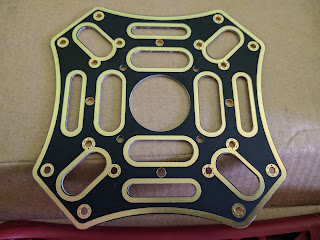I was going through a local hobby shop, and to my delight, I found that they had a
F450 Frame on sale. They said it's the last one in their current stock (but they said more stock is on the way). I'm still waiting for the
F550 frame I ordered from eBay. Although the F450 wasn't exactly the one I was looking for, I decided to buy it and give it a try also.
For those who aren't familiar, the F550 is a Hexacopter frame, while the F450 is a Quadcopter frame.
 |
| The F450 Fame I found |
The F450 I bought didn't have the DJI branding, so I'm guessing it's a clone. But I can say, it's quite a good quality one.
 |
| The F450 Top Plate |
The plates appear to be gold plated (at least, 'some shiny metal' plated). All the connection points are clean and solder padded.
The arms are made with a sturdy material, which should be able to take on a few crashes. And they are very well made.
 |
| The arms of F450 |
I really like the fact that the threads for screws in the arms are metal instead of plastic. That should make reassembling the frame multiple times much easier.
 |
| The metal threads for screws |
Overall, I'm extremely happy of the purchase. Hoping the F550 frame, which is on the way, is also of the same quality.
Now, I need to make a decision of which Transmitter I should buy for my multicopter. I have a choice between the
FlySky FS-i6S and the
RadioLink AT9S.
I'll be doing some research into those two Transmitter models next.




Comments
Post a Comment